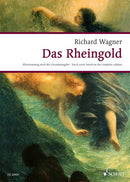| 作曲者 | Richard Wagner (1813-1883)・リヒャルト・ワーグナー |
| タイトル | Das Rheingold WWV 86 A(ヴォーカル・スコア) |
| サブタイトル | Der Ring des Nibelungen |
| 出版社 | Schott・ショット |
| シリーズ名 | Wagner Urtext Piano/Vocal Scores |
| 楽器編成(詳細) | Picc. · 3 · 3 · Engl. Hr. · 3 · Bassklar. · 3 - 8 (5. u. 7. auch Tenortb.,6. u. 8. auch Basstb.) · 3 · Basstrp. · 4 (4. auch Kb.-Pos.) · Kbtb. - P. S. (Trgl. · Beckenpaar · Tamt.) (2 Spieler) - 6 Hfn. - Str. (16 · 16 · 12 · 12 · 8) Auf dem Theater: 1 Hfe. · 18 Ambosse · 1 Hammer |
| 品番 | 9790001154093 |
| 言語 | ドイツ語 |
| 形状 | 364 ページ・1190 g・ソフトカバー |
| 作曲年 | 1851-1854年 |
| 出版年 | 2010年 |
| 出版番号 | ED 20491 |
| ISMN | 9790001154093 |
| ISBN | 9783795798727 |
An important addition to our newly produced orchestral materials is the first publication of vocal scores of Wagner’s ten great operas, in every important version, based on the Complete Edition. The score corresponds to the performance materials from the Complete Edition.* For practical use in rehearsal cues and bar numbers throughout.* The publisher has secured the services of renewed musicologists associated with the Richard Wagner Complete Edition who convey detailed information in critical forewords.* The forewords are given in three languages (German, English, French)* Uniform and attractive front cover designs with reproductions of paintings from the Wagner era underline the series design of the edition. DAS RHEINGOLD “This piano score has been compiled on the basis of the edition of Rheingold in the critical complete edition of the musical works of Richard Wagner (Richard Wagner, Sämtliche Werke, Vol. 10, I-II, edited by Egon Voss, Mainz 1988f.). The primary source for the edition of Rheingold in the complete edition was the first print of the score (E) which was published by Schott’s Söhne, Mainz in 1873. Unfortunately, the source which would have been of greatest significance for revision purposes could not be utilised in the preparation of this edition, Wagner’s autograph fair copy of the score which was included in Ludwig II’s estate fell into the hands of Adolf Hitler in 1939 and has never been seen again since 1945. For this reason, it was necessary to make frequent reference to both the so-called compositional sketch (KS) and the first draft of the score (PE). For any questionable interpretations of E in the principle text, the variants in KS and PE have been added in small print or footnotes. This also applies to additional markings and alterations undertaken by Wagner during rehearsals for the first performances in 1876 which were recorded by his assistants, principally by Heinrich Porges. These variants are marked with the sign [1876]. Remarks in quotation marks reproduce Wagner’s original comments. At certain points, reference has also been made to the records by Felix Mottl who was also present at the rehearsals and performances in 1876. Further relevant information can be found in the volumes of the complete edition.” (Egon Voss, quoted from the foreword of the new Rheingold vocal score, translation by Lindsay Chalmers-Gerbracht)
Vorspiel und erste Szene (Auf dem Grunde des Rheines) - Zweite Szene (Freie Gegend auf Bergeshöhen) - Dritte Szene (Nibelheim) - Vierte Szene (Freie Gegend auf Bergeshöhen)



